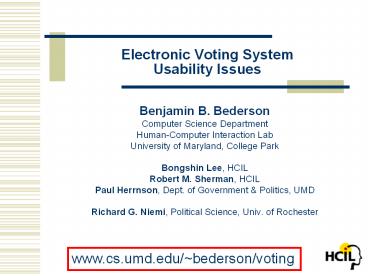Electronic Voting System Usability Issues - PowerPoint PPT Presentation
1 / 31
Title:
Electronic Voting System Usability Issues
Description:
Electronic Voting System Usability Issues – PowerPoint PPT presentation
Number of Views:73
Avg rating:3.0/5.0
Title: Electronic Voting System Usability Issues
1
Electronic Voting System Usability Issues
- Benjamin B. Bederson
- Computer Science Department
- Human-Computer Interaction Lab
- University of Maryland, College Park
- Bongshin Lee, HCIL
- Robert M. Sherman, HCIL
- Paul Herrnson, Dept. of Government Politics,
UMD - Richard G. Niemi, Political Science, Univ. of
Rochester
www.cs.umd.edu/bederson/voting
2
Voting System Importance
- The manner in which voters cast ballots is
important - Voting technology and ballot design can
influence - election outcomes
- voters trust
- which affects future elections
3
Voting System Technologies
- Wide range of available systems from
- paper and tally sheets
- punch cards with chad
- mechanical lever machines
- To more recent technologies
- optical-scan machines
- Direct Recording Electronic - DREs(touch-screens)
4
US Political Scene
- After the US 2000 general election, there was a
flurry of activity - major problems
- 4-6 million presidential votes lost in 2000
- hanging chad, etc.
- see CalTech/MIT Voting Technology Report, 2001
- public awareness of unequal voting systems,
widespread complaints, and new knowledge of
system limitations - calls for new systems
- So, how to make a judgement?
5
Other Studies
- A range of research in this area
- Historical ballot design studies
- Caltech/MIT Study
- But few investigations about usability
6
Learn from the Field of HCI
- Electronic voting systems offer
- Control font size
- Switch languages
- Accommodate disabilities
- Accurate and fast vote tabulations
- But have unique challenges
- Must work for everybody
- including elderly, disabled, uneducated, etc.
- Walk up and use (no required training)
- No external help (although it is allowed)
- Not frequently used
7
Our Study
- Requested by four counties in Maryland to examine
their new machines (Diebold AccuVote-TS). - 30 days from first call to report
- No funding
- Machines to be used by 1,000,000 people in 2002
general election - We agreed to perform
- Expert review (5 reviewers)
- Close-up observation (47 users)
- Field testing (415 users)
8
Study Screens
9
Study Screens
10
(No Transcript)
11
(No Transcript)
12
(No Transcript)
13
(No Transcript)
14
(No Transcript)
15
Expert Review
- Five HCIL faculty/staff analyzed system.
- Concerns
- Inconsistent terminology/labeling (5)
- Color usage (4)
- Inserting / removing card (4)
- Help / Instructions (4)
- Layout (long names, many candidates?) (4)
- Screen glare (3)
- Changing selection (2)
- No overvote feedback (2)
- Privacy (1)
16
Expert ReviewAudio-only System
- Concerns
- Inappropriate keypad mapping (5)
- Audio quality (5)
- No ballot review (3)
- No button feedback (2)
- No overvote warning (2)
- Must review entire ballot (2)
- Volume control (1)
17
Close Observation
- Observed 47 UMD members
- Primarily students
- Same toy election
- Used think aloud protocol
- Average time was 2 minutes, 10 sec
- One participant couldnt figure out how to
write-in a candidate
18
Close Observation Results
- Overall rating (1-9, 9 being positive)
- Overall comfort 7.7
- Screen layout and color 6.9
- Representative comments
- Easy to use, straightforward
- Excellent idea
- Inserting card was very confusing
- Is it reliable?
- Colors are not well chosen
- Font could be bigger
- Ballot layout was confusing
19
Close Observation Comments
- System Failure
- One card got stuck in reader
- Card Insertion
- Many participants had difficulty, expecting
ATM-style interaction - Language Selection
- Participants got stuck
- Undervotes not highlighted
20
Field Study
- Great expectations
- Observation and recording of interaction
- Questionnaire
- Administer to representative sample
- Reality
- Study executed by election officials
- No observation or notes on use
- Sample from wealthier and more educated districts
21
Field Study Results I
- Ratings (1-9, 9 being positive)
- Overall impression
- 8-9, 80
- 7, 10
- 1-6, 10
- Felt comfortable using system
- 8-9, 86
- 7, 7
- 1-6, 7
- Ease of reading text
- 8-9, 86
- 7, 8
- 1-6, 6
22
Field Study Results II
- Terminology used
- 8-9, 83
- 7, 10
- 1-6, 7
- Correcting mistakes was easy
- 8-9, 81
- 7, 11
- 1-6, 8
- Trusted votes were recorded properly
- 8-9, 85
- 7, 7
- 1-6, 8
23
Field Study Interpretation
- 10 that rated 6 or lowerequals 383,000 voters
- City/suburban dwellers rated higher
- Women rated higher
- Frequent computer users had lower trust
24
Diebold AccuVote-TSDeployed at 2002 General
Election
25
(No Transcript)
26
(No Transcript)
27
(No Transcript)
28
(No Transcript)
29
(No Transcript)
30
(No Transcript)
31
Conclusion
- Studies leave us optimistic, but concerned
- With elections called by 1, leaving 10
unconfident voters is a problem - The requirements of DREs are unique, but the
design issues arent - Typical of public access information systems
- Need closer work with HCI professionals
- Need qualitative and quantitative user studies
- Need further field studies
- Come see voting panel tomorrow morning
www.cs.umd.edu/bederson/voting































